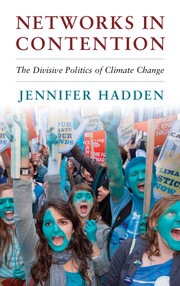Book contents
- Frontmatter
- Dedication
- Contents
- List of Figures
- List of Tables
- Acknowledgments
- Introduction
- 1 The Copenhagen Moment
- 2 The Emergence of a Divided Civil Society Network
- 3 A Network Approach to Collective Action
- 4 Conventional Climate Advocacy
- 5 Climate Justice Activism
- 6 Implications for Climate Change Politics
- Conclusion
- Main Abbreviations Used
- Methods Appendix
- References
- Index
- Books in the Series
Introduction
Published online by Cambridge University Press: 05 April 2015
- Frontmatter
- Dedication
- Contents
- List of Figures
- List of Tables
- Acknowledgments
- Introduction
- 1 The Copenhagen Moment
- 2 The Emergence of a Divided Civil Society Network
- 3 A Network Approach to Collective Action
- 4 Conventional Climate Advocacy
- 5 Climate Justice Activism
- 6 Implications for Climate Change Politics
- Conclusion
- Main Abbreviations Used
- Methods Appendix
- References
- Index
- Books in the Series
Summary
It was a bright and unseasonably warm winter day. People streamed into Copenhagen by early morning to participate in an event billed as the “Global Day of Climate Action.” It was a big success. The crowd snaking through the streets approached 100,000 at its peak. Protesters held signs that read “There is no Planet B” and “Bla Bla Bla … Act Now!” to reference the urgency of the ongoing climate negotiations. The sun had set by the time the protesters reached the venue of the climate summit. The crowd assembled in the dark, illuminated by the glow of candles as Desmond Tutu led a vigil for climate protection. Speaker after speaker beseeched world leaders to act on the critical challenge of climate change. Individuals in the crowd linked arms and sang songs of solidarity.
A very different scene was unfolding simultaneously across town. While the “family-friendly” march was making its way toward the venue of the conference, approximately 2,000 individuals fell behind. Many of these activists formed their own bloc to march separately from the rest of the protesters. They distinguished themselves by wearing black clothes and bandanas. A few broke off to smash windows and spray-paint buildings as they began to leave the downtown area. The Danish police responded by arresting more than 700 individuals that morning. Many of those arrested were made to sit on the sidewalk for more than five hours. Those that were not arrested continued their march, holding banners proclaiming “change the system, not the climate” and “climate justice now!” They linked arms, closed ranks, and maintained their distance from the other marchers assembled in front of the venue, drumming and chanting for climate justice from a site about half a mile away from the other activists.
This event, in Copenhagen in 2009, was the moment at which the world anticipated a successor agreement to the Kyoto Protocol.
- Type
- Chapter
- Information
- Networks in ContentionThe Divisive Politics of Climate Change, pp. 1 - 15Publisher: Cambridge University PressPrint publication year: 2015
- 1
- Cited by

